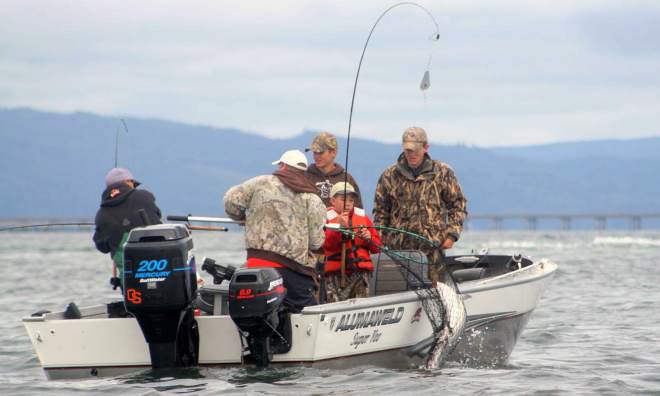forum
library
tutorial
contact

Proposed Ocean Fishing Regs Reflect
Downturn in Chinook, Coho Abundance
by Laura Berg
NW Fishletter, April 4, 2016
|
the film forum library tutorial contact |

|
Proposed Ocean Fishing Regs Reflect
by Laura Berg
|
 It's a good bet that Pacific Ocean salmon harvests are going to take a dip this year, based on plans proposed by fish managers.
It's a good bet that Pacific Ocean salmon harvests are going to take a dip this year, based on plans proposed by fish managers.
The Pacific Fishery Management Council (PFMC) released three options for 2016 ocean fisheries on March 14, reflecting a lower abundance of Chinook and coho than in the past several years.
The council will select among the three alternatives at an April 9-14 meeting in Vancouver, Wash.
The agency sets fishing seasons in U.S. waters 3 to 200 miles off the Pacific coast, and covers commercial, recreational and tribal ocean fisheries.
In 2016, coho returns are expected to be so poor that one PFMC option would completely shut down fisheries off the Washington coast.
Jim Unsworth, Washington Department of Fish and Wildlife director, said in a March 14 statement that although regulators are hopeful there will be some fishing opportunities, their first priority must be conserving the diminished number of wild coho anticipated this year.
"The mix of salmon runs this year is unusual," PFMC Executive Director Donald McIsaac wrote in an agency blog entry.
"In the north, the return of fall Chinook to the Columbia River is forecast to be exceptionally high again, but expectations for wild coho runs to the Washington coast and Puget Sound areas can only be described as disastrous," he added. "In the south, the Sacramento River fall Chinook are healthy, but Klamath River fall Chinook are so poor that the Council's policy calls for a low 'de minimis' catch in ocean fisheries."
The poor returns of some key Pacific stocks are being attributed to environmental conditions such as the California drought, El Niño and warmer water temperatures.
The options for ocean Chinook catches range from 144,800 to 232,400 in commercial fisheries and 49,500 to 115,900 in sport fisheries.
Last year's commercial ocean harvest totaled 328,500 Chinook, while the recreational harvest was 86,300 fish.
The tribal Chinook ocean catch alternatives range from 30,000 to 50,000 fish, compared with nearly 60,000 last year. The Quinault, Hoh, Quileute, Makah and S'Klallam tribes conduct fisheries in ocean waters off Washington's coast.
The possibilities for ocean coho harvests range from zero to 47,200 fish in commercial fisheries and 21,000 to 77,800 in recreational fisheries.
Last year's commercial ocean catch totaled 9,000 coho, while the recreational harvest was 99,500 fish.
For tribal ocean harvests of coho, options range from zero to 40,000 fish, compared with a catch of 4,000 in 2015.
Once the PFMC selects a single season option at its April meeting, that choice will be recommended to NOAA Fisheries for final approval by May 1.
learn more on topics covered in the film
see the video
read the script
learn the songs
discussion forum
